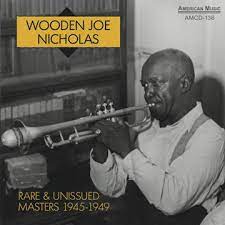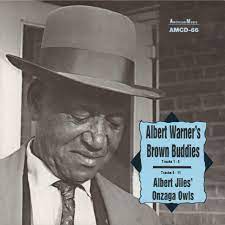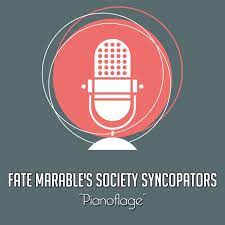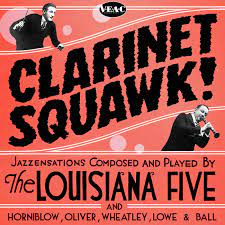
Daily Dose Of Jazz…
Louis Keppard was born February 2, 1888 in New Orleans, Louisiana and was the older brother of cornetist Freddie Keppard. The guitarist played in the Cherry Blossom Band before leading his own group, the Magnolia Band, which included King Oliver and Honore Dutrey among its members.
He played with Papa Celestin’s Tuxedo Brass Band, Manuel Perez, and followed that residency with the Olympia Orchestra alongside Freddie. In 1917 he moved briefly to Chicago, Illinois but returned soon after. Playing in several New Orleans brass bands, Louis performed as an alto hornist and guitarist from the 1920s through the 1950s, including in the Gibson Brass Band and the Young Excelsior Brass Band.
Keppard’s style of “shuffle rhythms” was an influence on Danny Barker. He recorded with Wooden Joe Nicholas in 1949, and retired from music some time after 1962.
Guitarist, tubist and alto hornist Louis Keppard, who led a band but never recorded as a leader, died in his hometown sixteen days after his 98th birthday on February 18, 1986.
More Posts: alto horn,guitar,history,instrumental,jazz,music,tuba

Daily Dose Of Jazz…
Albert Warner was born on December 31, 1890, in the Tremé neighborhood of New Orleans, Louisiana. Though his father was a string bass player, he didn’t seriously pick up the trombone until he was twenty-two years old. Taking lessons from one of his half-brothers, Ulysses Jackson, as well as Arthur Stevens and Honoré Dutrey. His main influences in his youth came from hearing Freddie Keppard, Vic Gaspard, and Baptiste Delisle.
His first professional jobs were playing for dance bands, including those led by “Big Eye” Louis Nelson, Kid Rena, Wooden Joe Nicholas, Buddy Petit, and Chris Kelly. In 1932 Warner joined the Eureka Brass Band and remained a regular member of this group until his death in 1966. His musical interplay with Charles Sonny Henry in the Eureka band during the late 1940s and 1950s is remembered by many for its intricacy and beauty.
The early Forties saw Albert playing and recording with Bunk Johnson and George Lewis. He would record often throughout the 1950s and in the Sixties he could be found playing frequently at Preservation Hall, accompanying the Preservation Hall band on a number of tours with Kid Sheik and the Eureka Brass Band. He went on one Memphis tour with Billie and DeDe Pierce in 1965.
Warner left behind a number of sessions recorded and released by Commodore, Pax, Folkways, Atlantic, and American. The album Bunk Johnson 1942/1945, Eureka Brass Band and The Eureka Brass Band in Rehearsal, a number of recordings with Charlie Love, Peter Bocage with His Creole Serenaders and the Love-Jiles Ragtime Orchestra, released by American. He also appeared on other American label albums recorded by Punch Miller, John Casimir, Kid Sheik and appeared on Atlantic’s Jazz at Preservation Hall series.
Trombonist Albert Warner, who performed in the traditional and brass band genres, transitioned on September 10, 1966 in New Orleans.
More Posts: bandleader,history,instrumental,jazz,music,trombone

Daily Dose Of Jazz…
Fate Marable was born on December 2, 1890 in Paducah, Kentucky. His mother was a piano teacher who gave her son music lessons, both in reading music and playing piano. At the age of 17 he began playing on the Mississippi River steamboats. John and Joseph Streckfus hired him to replace their piano player, Charles Mills, who had accepted an engagement in New York City.
Later in 1907 he became bandleader for a paddlewheeler on the Streckfus Line running between New Orleans, Louisiana and St. Paul, Minnesota, a position he retained for 33 years. Later he spent late nights in New Orleans’ clubs scouting for talent and playing at jam sessions. There he discovered Louis Armstrong blowing cornet, and recruited him to play for his band on evening riverboat excursions cruising around the Crescent City.
As a bandleader, Marable shared the lessons from his mother with his musicians as many of the musicians he hired played by ear. He augmented their skills by teaching them to read music, and expected them all to learn how to play from sheet music on sight. His training boosted many of the musician’s careers when they were ready to move on. They went on to play with bandleaders such as Cab Calloway, Count Basie, Duke Ellington, Jimmie Lunceford, Fats Waller, and Chick Webb.
Members of Marable’s bands were expected to be able to play a wide variety of music, from hot numbers to light classics, playing by memory or ear, and from sheet music. As a strict bandleader he demanded musical proficiency and rigid discipline from all his band members as they developed their individual strong points. His band served as an early musical education for many other players who would later become prominent in jazz, including Red Allen, Baby Dodds, Johnny Dodds, Pops Foster, Erroll Garner, Narvin Kimball, Al Morgan, Jimmy Blanton, Elbert Pee Wee Claybrook, Joe Poston, and Zutty Singleton.
Pianist and bandleader Fate Marable, who published the only original composition of his career, Barrell House Rag, co-written with Clarence Williams in 1916, transitioned from pneumonia in St. Louis, Missouri on January 16, 1947 at 56 years old.
More Posts: bandleader,history,instrumental,jazz,music,piano

Daily Dose Of Jazz…
Ted Lewis was born Theodore Leopold Friedman on June 6, 1890 in Circleville, Ohio. His first instrument was the piccolo, however, he also learned to play the C-melody saxophone but was known principally as a clarinetist throughout his long career.
He was one of the first Northern musicians to imitate the style of New Orleans jazz musicians who came to New York in the 1910s. He first recorded in 1917 with Earl Fuller’s Jazz Band, a band attempting to copy the sound of the Original Dixieland Jass Band.
His earliest clarinet recordings were not very good but as his career gained momentum he refined his style under the influence of the first New Orleans clarinetists Larry Shields, Alcide Nunez, and Achille Baquet who relocated to New York.
By 1919, Lewis was leading his own band, and had a recording contract with Columbia Records. At the start of the Roaring Twenties, he was being promoted as one of the leading lights of the mainstream form of jazz popular at the time. He hired musicians Benny Goodman, Jimmy Dorsey, Frank Teschemacher, and Don Murray to play clarinet in his band. Over the years he hired trumpeter Muggsy Spanier and trombonist George Brunies as he led his band to be second only to the Paul Whiteman band in popularity.
One of his most memorable songs, Me and My Shadow, had usher Eddie Chester mimicking his movements during his act. He then hired four Black shadows, the most famous being Charles “Snowball” Whittier, making Lewis one of the first prominent white entertainers to showcase Black performers, albeit in stereotypical ways, to be onstage, on film, and eventually on network television.
Remaining successful through the Great Depression, Ted adopted a battered top hat for sentimental, hard-luck tunes. He kept his band together through the 1950s and continued to make appearances in Las Vegas, Nevada and on the popular television shows of the decade. He would go on to perform in the early talkie films by Universal Studios and Columbia Pictures.
Clarinetist, bandleader, and singer Ted Lewis, transitioned in his sleep from lung failure on August 25, 1971 in New York City. He was 81. His memorabilia resides in The Ted Lewis Museum, created by his wife Adah, located across the street from where he was born in Circleville.
More Posts: bandleader,clarinet,history,instrumental,jazz,music,vocal

Daily Dose Of Jazz…
Alcide Patrick Nunez was born on March 17, 1884 in St. Bernard Parish, Louisiana of Isleño and French Creole descent. The family moved to New Orleans, Louisiana when he was a child. Growing up amid the Marigny and Bywater districts of New Orleans, he joined several bands in which he played guitar, although switched to clarinet about 1902. He soon became one of the top clarinetists in the city. By 1905 he was a regular in Papa Jack Laine’s band, in addition to playing with Tom Brown and sometimes led bands of his own.
Though he could play several instruments, he mainly played the clarinet and was able to improvise variations on the songs he heard. Before he was able to make music a full-time profession, Nunez worked for a while driving a mule-drawn wagon with fellow musician Chink Abraham.
In early 1916, he went north to Chicago, Illinois with Stein’s Dixie Jass Band, but he left the band shortly before they made their first recordings. After spending some time playing with Tom Brown’s band in Chicago, he went to New York City with Bert Kelly’s band and became his bandleader. He went on to help form the Louisiana Five, led by drummer Anton Lada, becoming one of the most popular bands in New York that recorded for several record labels.
In 1922, after Bert Kelly replaced him with Johnny Dodds, he returned to Chicago to lead the house band at Kelly’s Stables and played with the band of Willard Robison. Soon thereafter Nuñez began to lose his teeth, impairing his ability to play clarinet. He returned to his family in New Orleans, but after getting dentures he regained his ability to play the clarinet. He joined the police department to join the Police Band and at the same time was a member of The Moonlight Serenaders band and several other dance bands that played in New Orleans.
For a time in 1921, he settled in Baltimore, Maryland where he bought a large house but eventually returned home to New Orleans. Clarinetist Alcide Nunez, who was also known as Yellow Nunez and was one of the first musicians of New Orleans to make audio recordings, transitioned from a heart attack on September 2, 1934.
More Posts: clarinet,history,instrumental,jazz,music





